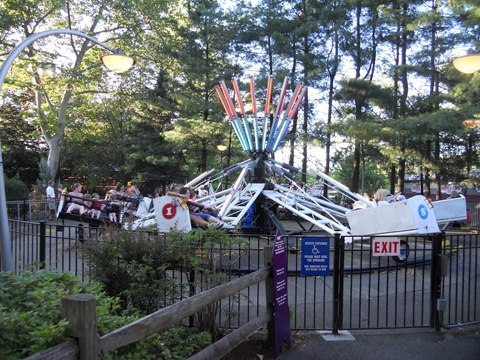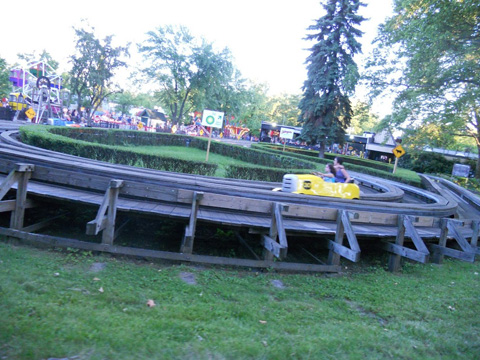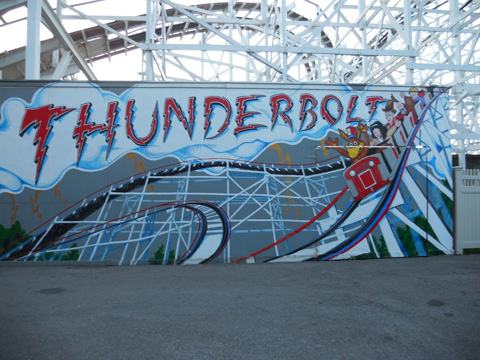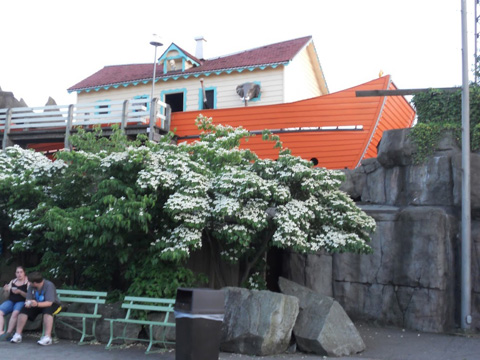|
|
|
| HOME ARTICLES GALLERIES ABOUT US FORUM LINKS CONTACT JOYLAND BOOKS | |
|
Pennsylvania's Picnic Groves and Trolley Parks (PAGE 1 OF 8) by Phil Gould Article: Added February 2013 |
|
|
During the past two years I have a made a couple of US road
trips through Pennsylvania and New York State. The main reason
for the jaunts has been to look at the amusement parks that
still survive in this region. While I did stop off at a few of
the large corporate theme parks my primary interest lay in
finding the old trolley parks and picnic groves that had
survived into the 21st century. For some reason this part of
America still has more than its fair share of these types of
parks in operation. They have many historic rides and
attractions that are now either unique or very rare to find.
Some of the parks are in slightly off beat locations. Most of
them seem to have a fairly short season only fully opening for
business on Memorial Day (the last Monday in May) and closing on
Labour Day (the first Monday In September). Despite this the
majority all seem to be able to invest in new rides while
preserving vintage attractions. Here I take a look at the
amazing attractions on offer at the parks in Pennsylvania. This
article isn't intended to be a comprehensive list of all of the
attractions on offer but a selective look at some of the
historical highlights and unusual rides.
|
|
|
Kennywood
Located in the Pittsburgh suburb of West Mifflin, Kennywood was originally set up as a trolley park by the Monongahela Streets Railway Company in 1898. Although many attractions in the park weren't opened until the following year. The park is one of only two in the States that are listed in the National Register of Historic Places. It remained family owned and operated until the end of 2007 when it was sold to California-based Palace Entertainments. Many people say that Kennywood is the US equivalent of Blackpool Pleasure Beach. I arrived at Kennywood on the first day on my trip. Although it was only early June the temperatures were in the 80s and it was strange to have left behind a grey, damp London only hours before and now to see everybody walking round in T-shirts and shorts as it was going dusk. The car park is on the opposite side of the road and you walk under a tunnel to reach the entrance. Despite the weather the park seemed relatively quiet during this visit although when I returned the following day it was packed out for a community event. I have to say that this turned out to be my favourite of all the parks visited in Pennsylvania. While it has modern rides it has managed to retain the feel of a traditional amusement park. As it is built on the side of a bluff some of the park's coasters make use of the terrain. This gives them unusual layouts which only adds to the fun. On entering the park you walk past the oldest ride still operating. Built in 1901 The Old Mill was the equivalent of the River Caves. Originally part of it was outdoors but the ride underwent a major remodelling in 1922 and a large building was constructed over all of the waterway. In 2004 the ride was rethemed as Garfield's Nightmare and became a 3D experience based on the famous cartoon cat's obsession with food. I have to admit it wasn't great, the novelty of 3D wore off way before the ride's conclusion. I understand that there is talk of turning the ride back into an Old Mill. Probably for the best. Opposite this ride you can see the Dutch Windmill, which was built on an island in the middle of the park's lagoon in 1928. It was relocated to its current position 12 years later. Adjacent to these I found a Kangaroo. Opened in 1962 this Norman Bartlett circular ride is still entertaining guests. I believe it is the only one left operating at a US amusement park and unlike the Flying Coasters left in the UK it still does jump over the hill. The centrepiece is pretty impressive with red and green neon tubes forming a crown. I was glad to see that this ride had been maintained. Not far away I found the Jack Rabbit roller coaster. Built in 1920 by legendary designer John Miller the coaster makes use of a natural gully meaning that you ride over two small dips before you reach the lift hill. The first dip is a double drop which sends you out of your seat and speeds the trains around the track. When it originally opened for business the coaster was the first one to have under-friction wheels. This meant designers could incorporate much steeper hills and and curved tracks into their design as the cars were now clamped to the track. It is the design still used on coasters today. Not far away from the coaster is the park's Grand Carousel. This is third such ride to grace the grounds but dates back to 1927. Four rows of animals are on the platform. It was too big for the park's previous carousel building (which is still used as a cafe) so a new one was built for the start of that season. The park seems very proud of the William Dentzel manufactured ride which was completely restored in 1976. It is a sight to behold in the evening when the lights shine next to the park's lagoon. There are no less than 72 horses, two chariots with a lion and a tiger on the platform. Walking around the lagoon I came to the next wooden coaster - The Racer. Following the success of The Jack Rabbit John Miller was called on to design this coaster too. He came up with the idea of a racing coaster. Although it appears to have two separate tracks it uses the Moebius system. So this is one continuous track, just like Blackpool's Grand National. But unlike its Lancastrian cousin the ride seemed much smoother when I rode it - if somewhat shorter in length. Coincidentally this opened the same year that Grand Carousel took its first turns by the lake. Continuing around to the bluff side of the park I spotted the Kiddieland section but just to the side of this was another of the park's unusual attractions the Auto Race. This Harry Traver built ride made its debut in 1930 when automobiles were becoming all the rage - if not widely available to everyone. It gave everybody the chance to take the wheel of a car around the wooden troughs. Originally there were small hills on the straight sections. These were removed in the 1940s after a few collisions in wet weather. Apart from this minor alteration the track follows the same route as it always has done. Like many parks fire is one of the greatest threats to historic attractions and one such event in 1975 saw Kiddieland losing some of its vintage rides. Luckily the W F Mangels Wheel, dating back to 1924 and the children's Turtle Chase (1950) survived. Although the children's Whip was lost a new one was purchased in 1985. Some people might not consider it to be true vintage, only dating back to 1970, but the Dizzy Dynamo is said to be unique and worth mentioning. A platform with spinning cars starts to turn and then the whole ride lifts and tilts. It's the first time I have ever seen anything like it in action. Next I came to my favourite coaster in the park. Again a wooden tracked ride. John Miller was called on (again) in 1967 to rebuild the park's most popular coaster The Pippin, which dated back to 1924. A year later the Thunderbolt took its first riders on what can only be described as a unique experience. As it is built on the very edge of the bluff you do not reach the lift hill until the middle of the ride. I can't think of many coasters where you leave the station and immediately plummet down a 50ft drop. You get spectacular views as the track dives in and out of a ravine. At one point the coaster turns in on itself leading to two parallel swooping drops in full view of the crowds below. A completely fantastic experience and yet again without any of the bumps and bangs that seem to be inflicted on riders on some of the UK's older wooden coasters. Perched on the cliff top next to the Thunderbolt is another ride which was once a staple of many amusement parks. The Turtle or Tumble Bug. Installed in 1927 the Traver manufactured ride sends passengers around an undulating track. The ordinary tubs were replaced by turtle shaped cars in the 1940s. Today it is one of only two such rides still operating, I would soon find the other one just 93 miles north from Kennywood at Conneaut Lake. Walking on towards the Lost Kennywood section of the park I spotted something that, as a child, was a familiar sight to me. Perched on top of Mount Ararat is the Noah's Ark. Introduced to visitors in 1936. designed and built by Herbert Schmeck it is now the only operating Ark in the world. For anybody who has never experienced one of these rides it is best described as a large walkthrough fun house inside a rocking boat. Kennywood first remodelled this ride in 1969. Then in 1996 the park was looking at introducing a new fun house attraction. But around the same time it was discovered that the Ark was in dire need of repair. The plans for a second fun house were scrapped and the Noah's Ark was virtually rebuilt. Today you ascend to the ark via an elevator before heading off along dark corridors and manoeuvring your way through through a series of gags. I have to say although I enjoyed myself I think the Blackpool version is better. A shame that it currently lies standing but not operating at the front of that park. The final vintage ride can be found in the Lost Kennywood section even though it has been at the park for many years. The Whip first opened up for business in 1919. A 12 car W F Mangels version that was replaced by a larger 16 car version eight years later. It is this ride that still operates to this day. Before saying farewell to Kennywood I suppose I should mention the park's railroad that dates back to 1945 taking passengers on a cliff top ride through the park's history. And then there is Laughing Sal, a crazy old mechanical lady, who used to welcome guests to the Laff In The Dark. Also worth a mention is the park's Midway. When new game stalls or food outlets have been added the buildings have always been constructed in sympathy with the historical attractions. Combined with all the modern attractions on offer this makes one great amusement park. One thing I would recommend is that you visit the park after dark and get to see all the neon lights which only adds to the atmosphere. I sincerely hope that I can return to Kennywood again one day. |
|
|
|
|
|
THEMAGICEYE | Terms and Conditions | Privacy Policy | Contact Us |
|






